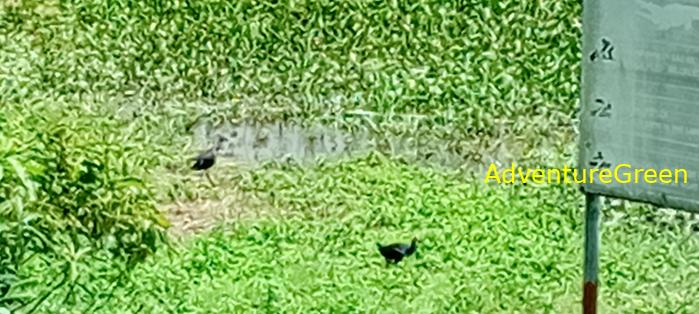Birds of Vietnam, Bird Species in Vietnam

Let's join AdventureGreen on our bird quests to learn about the different birds and bird species in Vietnam. Here you can find out more about the birding spots that these bird species are found.
- Order: Passeriformes
- Family: Timaliidae
- Genus: Spelaeornis
Naga wren-babbler
(Khướu đất đuôi dài, Spelaeornis chocolatinus)
(split from long-tailed wren-babbler)
The Naga wren-babbler (Spelaeornis chocolatinus) is a bird species in the family Timaliidae.
Timaliidae, Timalia: The word "Timalo" originates in the Greek "Thimalos", which means "bird". This Greek root was adapted to Latin as "Timalus" and later to Portuguese as "Timalo".
Spelaeornis: Greek spelaion: cave; ornis: bird.
schocolatinus German Schokolade chocolate.
- Order: Passeriformes
- Family: Timaliidae
- Genus: Spelaeornis
Bar-winged wren-babbler
(Spelaeornis troglodytoides)
The bar-winged wren-babbler (Spelaeornis troglodytoides) is a species of bird in the family Timaliidae.
The bird is found in Bhutan, China, India, and Myanmar.
Timaliidae, Timalia: The word "Timalo" originates in the Greek "Thimalos", which means "bird". This Greek root was adapted to Latin as "Timalus" and later to Portuguese as "Timalo".
Spelaeornis: Greek spelaion: cave; ornis: bird.
Troglodytes from the Greek word "troglodytes" troglē "hole", and dyein, "creep"), meaning "hole-dweller".
Greek oides means like, similar to, resembling.
- Order: Passeriformes
- Family: Timaliidae
- Genus: Stachyris
Gray-throated babbler
(Khướu bụi đầu đen, Stachyris nigriceps)
The grey-throated babbler (Stachyris nigriceps) is a species of passerine bird in the Old World babbler family Timaliidae.
The bird is found in Bangladesh, Bhutan, China, India, Indonesia, Laos, Malaysia, Myanmar, Nepal, Thailand, and Vietnam.
The genus name combines the Ancient Greek stakhus meaning "ear of wheat" and rhis, rhinos meaning "nostrils".
The specific epithet nigriceps is from Latin niger meaning "black" and "-ceps" meaning "-headed".
- Order: Passeriformes
- Family: Timaliidae
- Genus: Stachyris
Sooty babbler
(Khướu đá mun, Stachyris herberti)
The sooty babbler (Stachyris herberti), which is endemic to Laos and Vietnam, is a species of bird in the family Timaliidae.
Timaliidae, Timalia: The word "Timalo" originates in the Greek "Thimalos", which means "bird". This Greek root was adapted to Latin as "Timalus" and later to Portuguese as "Timalo".
Stachyris: combines the Ancient Greek stakhus meaning "ear of wheat" and rhis, rhinos meaning "nostrils" referring to the opercula almost closing the nostrils (nares).
- Order: Passeriformes
- Family: Timaliidae
- Genus: Stachyris
Spot-necked babbler
(Khướu bụi đốm cổ, Stachyris strialata)
Timaliidae, Timalia: The word "Timalo" originates in the Greek "Thimalos", which means "bird". This Greek root was adapted to Latin as "Timalus" and later to Portuguese as "Timalo".
Stachyris: combines the Ancient Greek stakhus meaning "ear of wheat" and rhis, rhinos meaning "nostrils" referring to the opercula almost closing the nostrils (nares).
strialata Latin striatus striated (striare to striate > stria furrow).
- Order: Passeriformes
- Family: Timaliidae
- Genus: Stachyris
Nonggang babbler
(Stachyris nonggangensis)
The Nonggang babbler (Stachyris nonggangensis) is a recently described species of bird in the family Timaliidae.
Timaliidae, Timalia: The word "Timalo" originates in the Greek "Thimalos", which means "bird". This Greek root was adapted to Latin as "Timalus" and later to Portuguese as "Timalo".
Stachyris: combines the Ancient Greek stakhus meaning "ear of wheat" and rhis, rhinos meaning "nostrils" referring to the opercula almost closing the nostrils (nares).
- Order: Passeriformes
- Family: Leiothrichidae
- Genus: Garrulax
White-crested laughingthrush
(Khướu đầu trắng, Garrulax leucolophus)
The white-crested laughingthrush (Garrulax leucolophus) is a member of the family Leiothrichidae.
The bird is bird found in forest and scrub from the Himalayan foothills to Southeast Asia.
Leiothrix Leiothrichidae Ancient Greek leios meaning "smooth" and thrix meaning "hair".
Garrulax comes from Latin garrire "to chatter"; Latin garrulus: babbling, chattering; -ax inclining towards.
leucolophus comes from Greek leukos "white" and lophos "crest".
- Order: Passeriformes
- Family: Leiothrichidae
- Genus: Garrulax
- French: Garrulaxe de Hainan
Rufous-cheeked laughingthrush
(Garrulax castanotis)
The rufous-cheeked laughingthrush (Garrulax castanotis) is a species of bird in the family Leiothrichidae.
This bird species is found only in China, Laos and Vietnam.
Leiothrix Leiothrichidae Ancient Greek leios meaning "smooth" and thrix meaning "hair".
Garrulax comes from Latin garrire "to chatter"; Latin garrulus: babbling, chattering; -ax inclining towards.
castanotis: Greek kastanon chestnut; -otis: -eared (ous,otos: ear).
- Order: Passeriformes
- Family: Leiothrichidae
- Genus: Garrulax
Grey laughingthrush
(Khướu xám, Garrulax maesi)
The grey laughingthrush (Garrulax maesi) is a species of bird in the family Leiothrichidae.
The bird is found in southern China, far northern Laos and Vietnam.
Leiothrix Leiothrichidae Ancient Greek leios meaning "smooth" and thrix meaning "hair".
Garrulax comes from Latin garrire "to chatter"; Latin garrulus: babbling, chattering; -ax inclining towards.
- Order: Pelecaniformes
- Family: Ardeidae
Oroanassa is a genus of Old World night herons typically found near water in forested regions.
The species of this genus was once placed in the genus Gorsachius.
1/White-eared night heron (Vạc hoa, Oroanassa magnifica)
(formerly Gorsachius magnificus)
other scientific names: Nycticorax magnificus
Ardeidae, Ardea: the Latin word ardea meaning "heron".
Oroanassa: Greek oros mountain; anassa queen, lady.
magnifica Latin magnificus splendid, grand (magnus great; facere to make).
- Order: Pelecaniformes
- Family: Ardeidae
- Genus: Oroanassa
White-eared night heron
(Vạc hoa, Oroanassa magnifica)
(formerly Gorsachius magnificus)
other scientific names: Nycticorax magnificus
The white-eared night heron (Oroanassa magnifica) is a species of heron in the family Ardeidae.
This bird is endemic to southern China and northern Vietnam.
Ardeidae, Ardea: the Latin word ardea meaning "heron".
Oroanassa: Greek oros mountain; anassa queen, lady.
magnifica Latin magnificus splendid, grand (magnus great; facere to make).
- Order: Passeriformes
- Family: Pellorneidae
- Genus: Napothera
White-Throated Wren-Babbler
(Napothera pasquieri)
The white-throated wren-babbler (Napothera pasquieri), endemic to the Northwest of Vietnam, is a species of bird in the family Pellorneidae.
Napothera:
Ancient Greek term napos (νάπος), meaning "timbered valley"
Thera borrowed from Latin Thēra, from Ancient Greek Θήρᾱ (Thḗrā): Thira, Santorini (an island in the Cyclades, Greece).
Greek θήρα, ας, ἡ, thēra: hunting, the chase
Greek napos ravine, gully; -theras hunter (therao: to hunt).
pasquieri: a French name.





































